If you’re planning a trip to Mount Rainier National Park and wondering what the park is like in different seasons, you’re not alone – and you’re asking a smart question.
Conditions at Rainier change dramatically month to month, and the experience you get in July will be completely different from one in November.
That’s exactly what this guide is here to help you with.
I’ve spent a lot of time in Mount Rainier National Park – and I’ve learned firsthand what to expect (and what can catch you off guard).
This is for you if you want to make the most of your visit, whether you’re after waterfalls, wildflowers, wildlife sightings, or snowy solitude.
I’ll walk you through what it’s like visiting Mount Rainier National Park month by month – weather, road access, events, seasonal highlights, and what you should know before you go.
Ready to figure out which season fits your ideal trip? Let’s take a closer look.
‼️ If you just want a quick snapshot about my thoughts on the best time to visit Mount Rainier National Park, check out my Best Time to Go to Mount Rainier National Park guide.
🛏️TOP HOTEL PICK: Check availability now
🚘FIND THE CHEAPEST CAR RENTAL: Search Discover Cars for the best deals
✈️FIND THE CHEAPEST FLIGHTS: Search Skyscanner for the best deals
🧳GET TRAVEL INSURANCE: Get insured with Travelex before you go
📱TAKE AN AUDIO TOUR: Buy an audio tour now
Table of Contents
Mount Rainier in Spring (April-June)
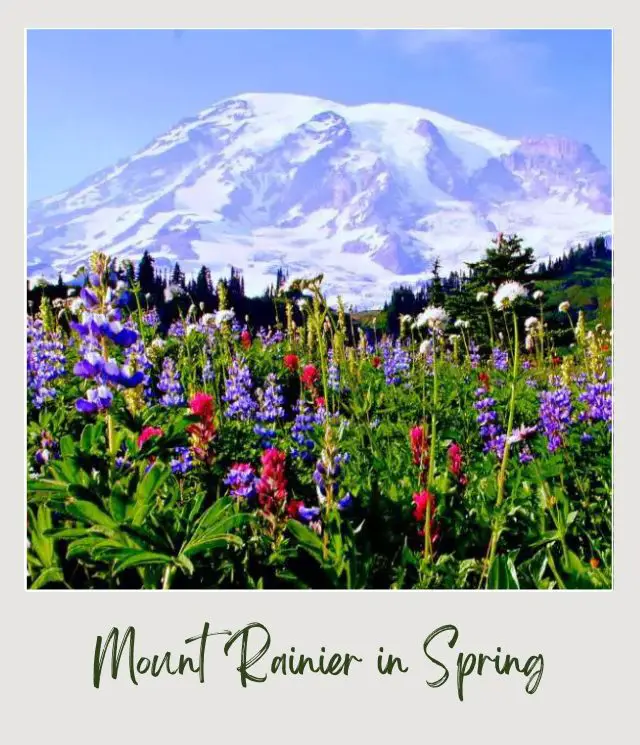
From April to June, there are some good things about visiting Mt. Rainier. Spring season sees the park start to open up again after the winter.
Snows start to melt at the lower altitudes and baby animals are born. The park’s waterfalls are especially impressive with the snowmelt. The busy summer season hasn’t started and there are a lot fewer people during this season so you can enjoy a more leisurely trip around the park.
Subscribe to daily national parks planning tips, travel inspiration and trip ideas and get instant access to the free PDF of this guide to
Visiting Mount Rainier National Park Throughout The Year
Visiting Mount Rainier in April
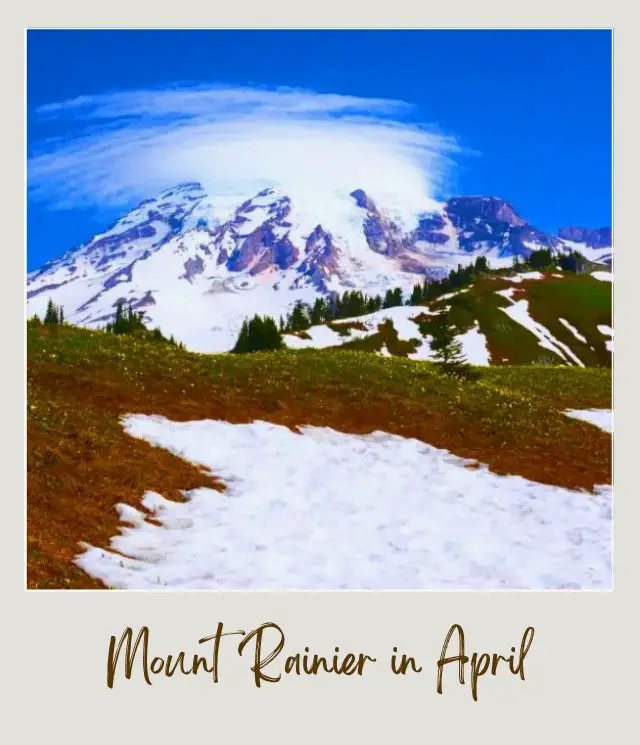
What’s there to see and do at Mount Rainier National Park in April? Is it the best time to visit the park? Not totally. Though it’s a beautiful time to see the park since the snow is melting and very early low altitude wildflowers are starting to bloom, you’ll expect unpredictable spring weather. Warm weather can quickly turn to cold steady drizzles within a day.
Expect temperatures to range from the low 30s to the high 40s. Weather can also determine the availability of park facilities like campgrounds, trails, and activities.
If you love hiking, you’ll find several trails at lower elevations that are suitable for spring hikes. Be sure to wear good quality hiking boots or gaiters because the trails are wet and muddy in this season. Read my Guide to the Best Hiking Shoes/ Boots for FAQs, tips on what to look for and recommendations and reviews if you’re looking to buy some new boots.
Seeing Mount Rainier’s waterfalls is also another thing to enjoy. Drive to Paradise to see the majestic views of Christine Falls and Narada Falls. Comet Falls, Carter, and Madcap Falls are also stunning this time of the year, along the Myrtle Falls which is one of the popular vistas at Mount Rainier.
Visitor Centers and Information Centers open during the season include the Longmire Museum and Carbon River Ranger Station.
Pros
- Scenic trails for spring hikes at lower elevations
- Waterfalls to visit
Cons
- Unpredictable weather
- Wet and muddy trails
- Many facilities and accommodations are not be available/ open
- The most popular trails are still covered in snow
Key Events in April:
✳️ National Park Week: Special events and programs and free entry one day this week
Visiting Mount Rainier in May
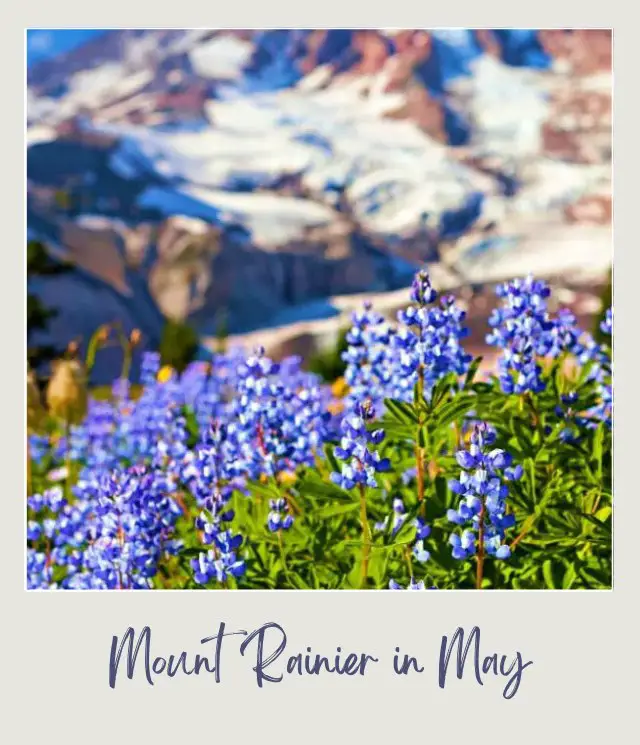
You’ll still expect some feet of snow at Mount Rainier in May, especially in the Paradise and Sunrise areas. Many of the park roads are still closed, though the Stevens Canyon entrance to Mount Rainier usually opens sometime in May.
Mt. Rainier weather in May is typically humid and cool, with daily temperatures ranging from a 59°F high to 39°F lows. Be sure to check weather forecasts before heading out to the park and have appropriate clothing and gear when hiking.
You can have a great waterfall experience in Mt. Rainier in May. Since snow is melting in the highland areas, the waterfalls at Mt. Rainier National Park are at the peak of their glory. Whether you’ll go for a scenic drive or plan to hike to get views up close, the sights are worth it. From parking areas along Paradise, you can already see the stunning view of Narada and Christine Falls from a distance.
You can also go for waterfall hikes and take the Paradise River Trail to see spectacular views of Carter and Medcap Falls. Likewise, the path to Conmet Falls gives you a good hike.
More park facilities also open at Mount Rainier National Park in May including the Henry M. Jackson Memorial Visitor Center at Paradise, along with Information Centers namely Longmire Wilderness Information Center, White River Wilderness Information Center, and Paradise Wilderness Information Center / Guide House. For your accommodation, you can stay at Paradise Inn which typically opens in late May.
You can camp or enjoy a picnic at the Cougar Rock and Ohanapecosh grounds and picnic areas which also open later in May.
So if you’re asking, “Is May a good time to visit Mt Rainier?’ It’s best to schedule your trip for later in May.
Pros
- See stunning waterfall views
- More park facilities open later in May
- No timed entry reservations are required for most of the month for Paradise
Cons
- Spring rainy weather during the day
- Many of the roads may still be closed
- Many facilities and lodgings are still closed until later in the month
- Most of the popular trails are still covered in snow
- Timed entry reservations are needed for the Paradise corridor starting in late May
- Sunrise area closed
Key Events in May:
✳️ Mother’s Day Buffet at the historic National Park Inn
Visiting Mount Rainier in June

June is summer in most parts of the country, but for most of Mount Rainier National Park, it is still spring. The weather in Mt. Rainier in June is warming up, though still cool and the higher elevation areas of the park are still snowy. The Paradise area is open, though the trails are typically covered in snow. You can still enjoy great hikes at Paradise and Longmire, including the famous Skyline Trail, but you’ll need to wear microspikes or other traction devices. If you need to buy some microspikes, read my Guide to the Best Microspikes for Hiking for tips and recommendations.
The popular Sunrise region doesn’t usually open until late June or even early July.
The good things is that in addition to this heading into the drier season in Mount Rainier National Park, June temperatures are increasing, ranging from the mid-60s to mid-40s.
At this time, you can also find additional park facilities opening at Mount Rainier National Park in June. The Ohanapecosh Visitor Center, White River Campground, and Paradise Picnic Area are available in the later weeks.
Pros
- Warmer temperatures
- Lesser rains
- Hiking trails at Paradise and Longmire
- Additional park facilities open later in June
- Crowds are lesser
Cons
- Most areas of the park are still closed
- Hiking trails can be mushy later in the day
- Timed entry reservations are needed for the Paradise corridor
- Sunrise area usually still closed
Mount Rainier in Summer (July-August)

July and August are peak seasons in Mount Rainier. Summer is short and the park becomes busy, especially on weekends and the Fourth of July. On summer weekends, you’ll need to get to some of the more popular spots like Paradise and Sunrise before 7:00am to get a parking spot!
You can avoid the heavy crowds by going there early or planning your visit during the weekdays.
Perhaps, you can also head out to more remote locations in Mt. Rainier. Summer offers equally great views along the park’s northwest section in the Carbon River area and the Gobblers Knob area in the southwest.
Visiting Mount Rainier in July
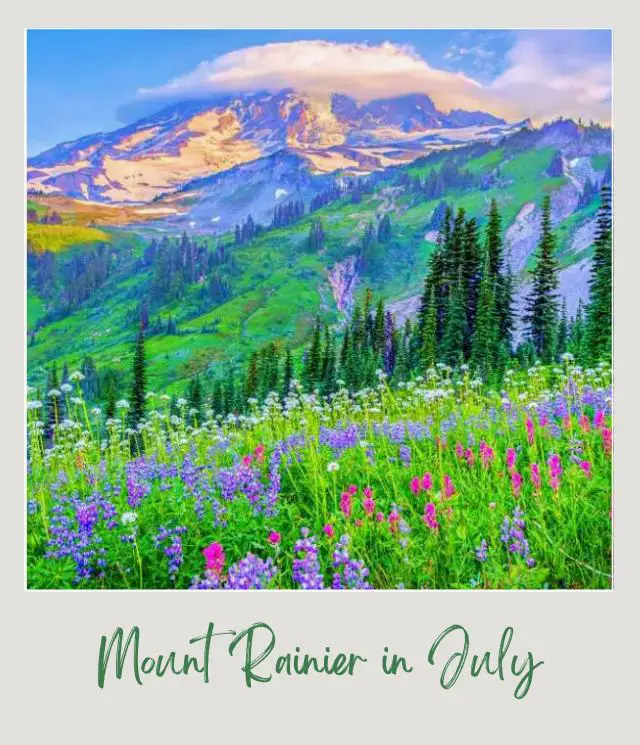
Summer is definitely the best time to visit Mount Rainier National Park. Wildflowers covering the meadows are in full bloom and warm weather is perfect for hiking and picnicking.
You can expect clearer skies during this time of the year with minimal fog and more favorable trail visibility. Mt. Rainier in July is fairly cool with highs ranging from the 60s to 70s. Average lows are around the mid-50s.
You can still expect lots of snow along the highland trails until the end of the month, so wear hiking boots and take microspikes if you’re planning to go on longer hikes like the Skyline Trail.
➡️ Read my Buying Guide to the Best Hiking Boots and Buying Guide to the Best Microspikes for Hiking if you’re looking to buy some.
Always check the weather at the location you’re heading to because weather conditions may differ from one area of the park to another.
Everything is usually open by early July, including the Sunrise Day Lodge and the Sunrise Visitor Center.
Pros
- Park season is at its peak
- Warm weather perfect for hiking and picnics
- Wildflowers are in full bloom by mid-July
- All areas of the park are usually open and accessible
Cons
- Park is crowded
- Parking is challenging
- Lines to entrance gates are long
- Snow persists on many trails well into July
- Timed entry reservations are needed for the Paradise corridor and Sunrise corridor
Key Events in July:
✳️ 4th of July Celebrations at Enumclaw
✳️ Mt. Rainier Annual Wine Festival at the Alpine Inn
✳️ Rails to Ales Event; Craft Brew Tasting & Train Ride at Mt. Rainier Railroad
✳️ Annual Pacific Northwest Highland Games at Enumclaw
Visiting Mount Rainier in August

The first weeks in August are the best times to see the wildflowers in Mt Rainier National Park. All park facilities are open so it’s a good time to visit and explore many of its attractions.
August also has the best weather, with an average temperature of 42 ˚F to 63 ˚F, with less rain than other months of the year, so you have the best chance of actually seeing the mountain. Nonetheless, you still have to be prepared because the weather at the park can easily change on any day.
Most of the park areas are snow-free at this time so you’ll enjoy some warmer hikes. Wildlife also roams the park so you’re likely to see elk, black bears, and mountain goats in the alpine areas.
Summer is also the season for bugs and mosquitos in Mount Rainier so bug spray is a must during hikes. ➡️ Get some DEET-free insect repellant here if you need some.
Pros
- All park facilities are open
- Best wildflower views in the season
- Spotting wildlife
- All areas of the park are usually open and accessible
Cons
- Park is crowded
- Parking may be limited
- Lines to entrance to gates are possibly longer
- Timed entry reservations are needed for the Paradise corridor and Sunrise corridor
Key Events in August:
✳️ Anniversary of the Great American Outdoors Act (free day at the park)
Mount Rainier: Fall (September-October)

Mt. Rainier in fall offers you a different feel of the park with fall colors starting to replace most of the lush greens. The best time to see this fall foliage is around the first few weeks of October since many of the park trails start to close by late October because of snow conditions. Mount Rainier in fall also lets you enjoy the park attractions minus the large crowds.
Visiting Mt Rainier in September

Is it a good time to visit Mount Rainier in September? Yes.
Two good reasons to plan your trip during the fall season? There are a lot fewer people in the park right after Labor Day and the weather is good at this time of the year. I’ve been the week after Labor Day and it was easy to get a park, the trails weren’t super crowded and the weather was perfect!
The main areas are snow-free so you’ll enjoy the cool rainforest climate while hiking the trails. Many of the plants are still green and there are even some late-season wildflowers on some meadows, but you’ll start to see more orange and red hues taking place around the park.
Black bears and deer are also active during the season so you’re likely to spot them along the trails.
Fall weather at Mount Rainier National Park in September averages between highs of 68°F and 45°F low temperature. You can access all park visitor centers and facilities at this time, but when snowfall starts in Mount Rainier in late September, some park facilities also close for the coming winter season.
Visitor Centers in Sunrise and Ohanapecosh close in mid-September. Paradise Inn also ends its open season while Sunrise Day Lodge and Paradise Wilderness Information Center / Guide House close earlier during the month.
Pros
- Fewer people
- Stunning fall colors
- Spot some wildlife
- No timed entry reservations are required for most of the month
Cons
- Some park facilities start to close by the end of the month, including Sunrise
- Timed entry reservations are needed for the Paradise corridor and Sunrise corridor for the first couple of days in September
Key Events in September:
✳️ National Public Lands Day (free day at the park)
Visiting Mt Rainier in October
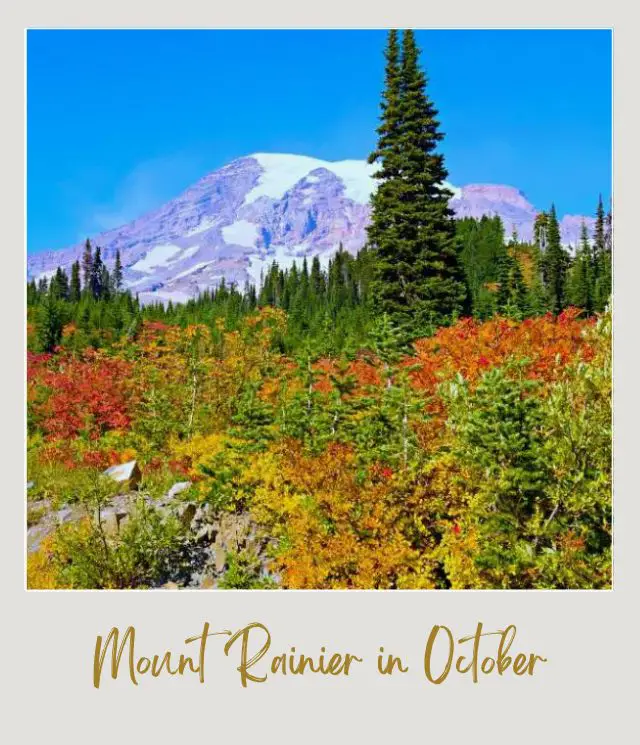
Mount Rainier in October gives you brilliant Autumn colors and cooler weather. Crowds thin out by this time since rain also starts to be more frequent.
Is it a good time to visit Mount Rainier National Park in October? Visiting the park during the early weeks is best so you can enjoy the fall foliage at the peak of its colors. Mt. Rainier October weather ranges between highs of 48°F and average lows of around 32°F.
The fall season is also the best time to see wildlife. You’ll see black-tailed deer roaming around the Paradise meadows and hoary marmots and pikas making their typical whistling high-pitch calls. Black bears are also more visible feeding on berry patches. They’re feeding to gain as much weight as possible and prepare themselves to hibernate for winter.
You can also enjoy berry-picking at Mt. Rainier. Fall season is when huckleberries, blackberries, thimbleberries, and salmonberries are ripe. You’ll find plenty of these berries along Sunrise, Paradise, the Naches Peak Loop, and the Tipsoo Lake-Chinook Pass.
By late October, chances of snow start to increase, so make sure to prepare for the cold weather if you’ll be visiting at that time. Also, the Longmire Wilderness Information Center and White River Wilderness Information Center close in mid-October.
Pros
- Stunning all foliage colors
- Spotting more wildlife
- Picking berries
- Cooler weather
- Crowds have thinned out
- No timed entry reservations are required for most of the month
Cons
- Snow starts later in the month
- Many accommodations and facilities close during this month
Visit Mount Rainier in winter (November-March)
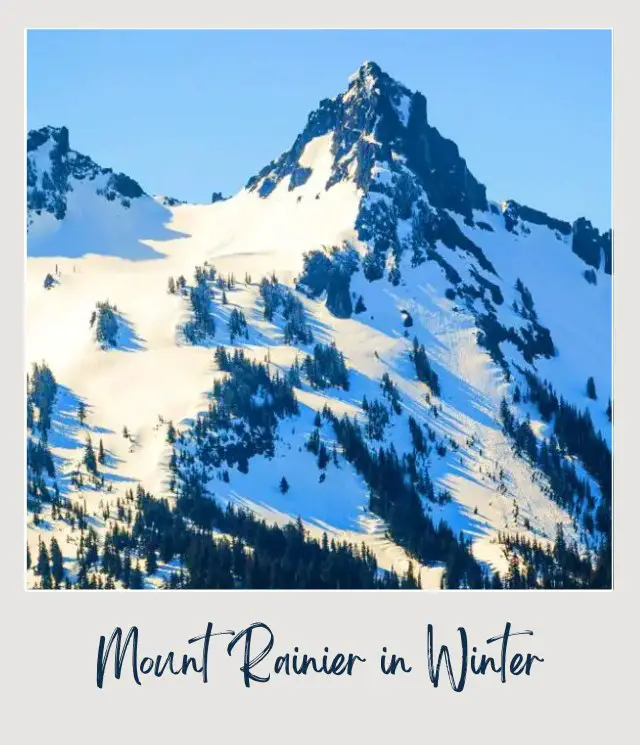
Mount Rainier National Park is known to be one of the “snowiest” places in the country. Does Mt Rainier always have snow? It’s capped with glaciers so the highest elevations have snow all year, but the main areas casual visitors go to are clear in summer but snowy in winter.
Winter here lasts for several months and is really cold. Paradise has an annual average snowfall of around 640 inches, which measures more than 50 feet. This makes Mount Rainier snow perfect for winter activities. The park is stunningly beautiful with the thick and heavy snow. And there are a lot fewer people at this time.
The southwest Nisqually Entrance and the Carbon River Entrance are the only entrances open at Mount Rainier National Park in winter. Though the Carbon River Road is only accessible to foot traffic and bicycles, vehicles are only allowed at this park entrance.
Can you visit Mt Rainier in the winter with a car? Yes. But in any weather condition, the park requires all vehicles to carry tire chains during the winter season for safety precautions while visiting the park.
Most of the roads are closed in Mount Rainier National Park in winter, so make sure you check accessible roads. Roads from Nisqually Entrance to Longmire are accessible all year-round but closes when weather is extreme, while roads along Longmire and Paradise opens only on weekends and closes every night.
If you’re visiting Mt Rainier in winter, plan your travel well and always get information on road status and weather forecasts, and keep yourself updated with possible winter hazards.
Visiting Mt Rainier in November

As the season shifts to winter in Mount Rainier National Park, November isn’t really a good time to visit the park. Rain is often non-stop and the weather is mostly cloudy. So if you’re aiming to go sightseeing, it’s not the best time to do so.
You may still be able to go on some hikes but make sure you’re prepared for the trip and be aware of sudden weather changes. Mt Rainier winter temperature in November ranges from 39°F highs to 28°F lows.
It’s still possible to visit Mt Rainier in winter but basically, you won’t enjoy much of it until around mid-December when snow is thick enough for winter activities. The Henry M Jackson Memorial Visitor Center at Paradise still opens on the weekends, along with the Longmire Museum and Carbon River Ranger Station which are open all year round.
Pros
- Fewer crowds
Cons
- Mostly rainy and cloudy weather
- Most accommodations and park facilities are closed for the winter
- There usually isn’t enough snow for winter activities, but too much for summer activities
Visiting Mount Rainier in December
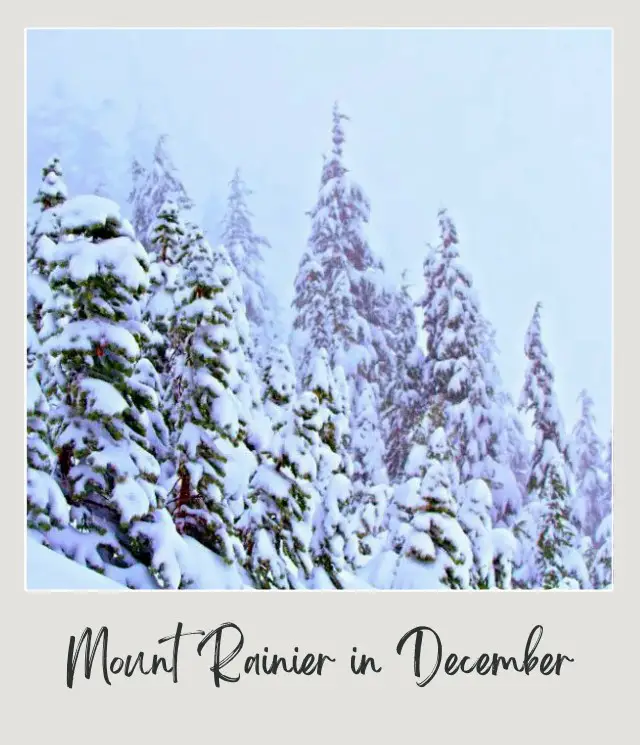
Mount Rainier National Park in December has abundant snowfall and gives park visitors lots of opportunities to enjoy winter recreation. By the middle of December, you’ll see the spectacular winter scenery as the park gets covered with blankets of snow.
Is it a good time to visit? Yes, if you love winter. The weather is in its coldest months with high temperatures averaging around 33.8°F and an average low of 21°F. The snow is thick enough for snowshoeing, snowboarding, sledding, and skiing.
➡️ Read my Guide to the Best Snowshoes for Beginners if you’re looking to buy some.
You can go for snow walks or winter camping in Paradise, Mazama Ridge, and Reflection Lakes. You can get a wilderness permit at the Longmire Museum or the Longmire Wilderness Information Center.
Another advantage of taking the Mt Rainier National Park winter trip is the cheaper rates during the season, particularly from December to January. You’ll get the best prices this time of the year.
Pros
- Great time to enjoy winter activities
- Spectacular winter landscape
- Cheapest vacation rates
Cons
- Weather is at its coldest
- Park facilities are limited
Visiting Mount Rainier in January
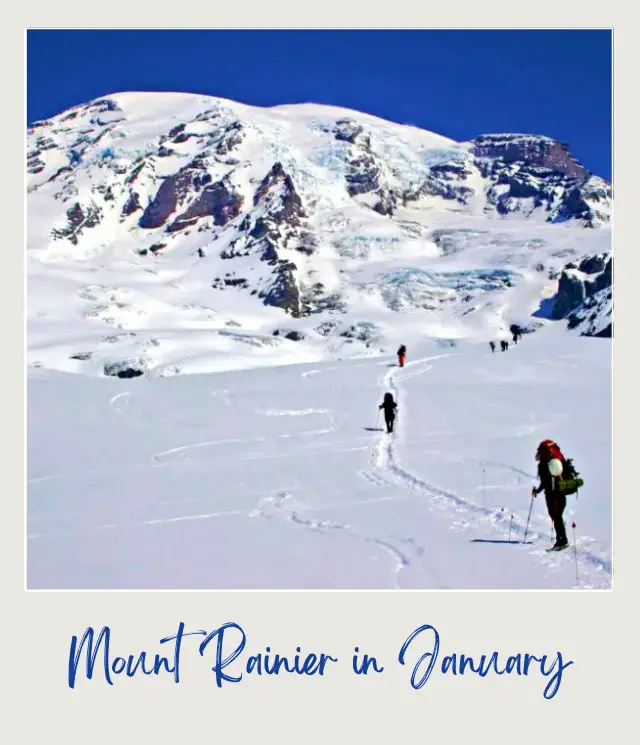
Temperatures in Mount Rainier in the winter range between 23˚° F to 35°˚F. Mount Rainier’s weather in January is pretty much the same as in December so the park is still full of winter activities like cross-country skiing, snowboarding, and hiking. When you go for winter hikes, make sure to check on road closures and avalanche warnings for your safety.
You’ll also enjoy Mount Rainier National Park winter activities like weekend snowshoe tours led by rangers.
If you’re planning an overnight stay, National Park Inn just next to Longmire Museum is open even during winter. Also, you’ll find several sledding areas in Paradise and snowmobile sites along Westside Road and loop roads on Cougar Rock Campground.
Pros
- Stay overnight at National Park Inn
- Winter Activities
Cons
- Inclement weather
- Many areas of the park are closed and even Paradise is often closed on weekdays
Key Events in January:
✳️ Martin Luther King, Jr. Day (free day at the park)
Visiting Mount Rainier National Park in February

Is it a good time to visit Mount Rainier in February? Yes, if you want to make the most of the park’s wintry month. Snow accumulations during this season can reach up to 8 feet. Rains are still frequent and days are still shorter, so you’ll need to constantly check for weather and road advisories when you tour around the park.
Temperatures Mt. Rainier in February typically average between 22°F and 38°F. If you plan to visit this time of the year, pack extra layers of clothes, boots, coats, and snow gear.
Read more:
➡️ Guide To The Best Men’s Boots For Winter
➡️ Guide To The Best Winter Boots For Women
➡️ Guide To The Best Winter Jackets For Extreme Cold
➡️ Guide to The Best Snowshoes for Beginners
➡️ Guide to the Best Microspikes for Hiking
You can still enjoy fun snow activities including camping, sledding, climbing, and much more before the start of spring in the next coming months. You can only access park facilities open year-round like Longmire Museum, Henry M Jackson Memorial Visitor Center at Paradise on the weekends, and Carbon River Ranger Station.
Pros
- Winter Activities
Cons
- Freezing temperatures
- Most areas of the park are closed
Visiting Mt Rainier National Park in March
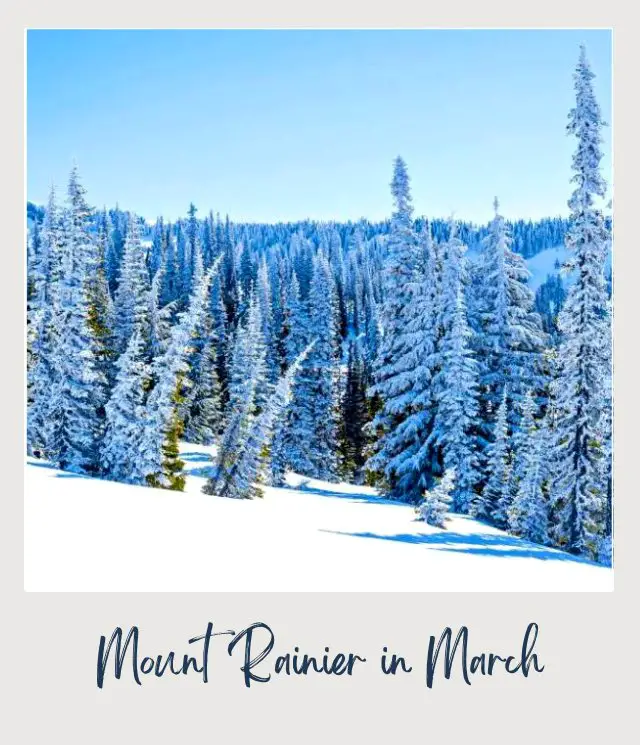
Though it’s spring in most parts of the country, March is still cold in Mt. Rainier. Snow still covers much of the park with around seven and a half feet of snow accumulations. Average highs are usually 37˚F lows can go around 23˚F.
Is it a good time to visit Mount Rainier? Not really, because on an average day, there’s almost a 50% chance of snow or rain. It’s also the rainiest month in the park and very humid. Since Mount Rainier’s weather is really cold and wet, the bottom line is March is one of the worst times to visit the park.
Though sledding areas are still open at this time and you can probably still do some winter activities, you won’t get to enjoy much because of the weather.
Pros
- Very few crowds
- Winter activities are still available
Cons
- Frequent rain and snow
- The wettest month in the park
Deciding when to go to Mount Rainier National Park is a very important step in planning your trip, and I hope this guide is helping.
However, as I’m sure you’re very aware, this is just one thing of many to decide. Once you’ve decided the timing of your trip, you still need to make an actual plan.
In fact, the thing that most people ask me about is how to put it all together into an itinerary that makes sense. They decide when they’ll go and maybe even book their flights, but still worry about how to minimize the crowds, what to do – and when – and how to coordinate it all.
To help take away the overwhelm of planning a trip to Mount Rainier National Park, I’ve created several super detailed itineraries.
Without them, people often feel stressed about planning their trip. With them, they have the confidence of getting all the info they need in one spot. Plus, there’s flexibility built in, so they can easily adapt them to their own interests and activity levels.
There are 1-, 2-, and 3- day options for Mount Rainier National Park: all with detailed hour-by-hour schedules, including alternatives for different activity and fitness levels, plus trail maps and descriptions, driving instructions, important information, essential tips, and everything else you need to make the most of your time in Mount Rainier National Park.
Travel Insurance for Mount Rainier National Park
No matter what when you go to Olympic National Park, you should definitely get travel insurance. This can protect you not only against medical and emergency repatriation, but can also cover things like trip cancellation, loss and/ or theft of property, etc.
➡️ A great insurance option is Travelex. It has coverage for all you’ll need. You can compare Travel Insurance plans here or get a quote right now:
Enjoy Mount Rainier National Park!
More Planning Resources for Mount Rainier National Park
⭐ Mount Rainier National Park Guide
⭐ Mount Rainier National Park Itineraries
⭐ Planning a Trip to Mount Rainier National Park: 7 Mistakes to Avoid
⭐ How many days in Mount Rainier National Park do you need?
⭐ Best Hikes in Mount Rainier National Park
⭐ The Skyline Trail Guide
⭐ How To Get to Mount Rainier National Park
⭐ All the Airports Near Mount Rainier National Park
⭐ The Closest Airport To Mount Rainier National Park
⭐ Best Time To Visit Mount Rainier National Park
⭐ 10 Tips For Visiting Mount Rainier National Park
⭐ 10 Fun Facts About Mount Rainier National Park
What do you think is the best time to visit Rainier National Park? Join my private Facebook group National Parks Collectors and comment and let me know (you can also pick up extra planning tips, share your photos and stories with other national park lovers and more).
Subscribe to daily national parks planning tips, travel inspiration and trip ideas and get instant access to the free PDF of this guide to
Visiting Mount Rainier National Park Throughout The Year
If you liked this article about what to expect each month in Mount Rainier, Pin It to your Mount Rainier National Park board!
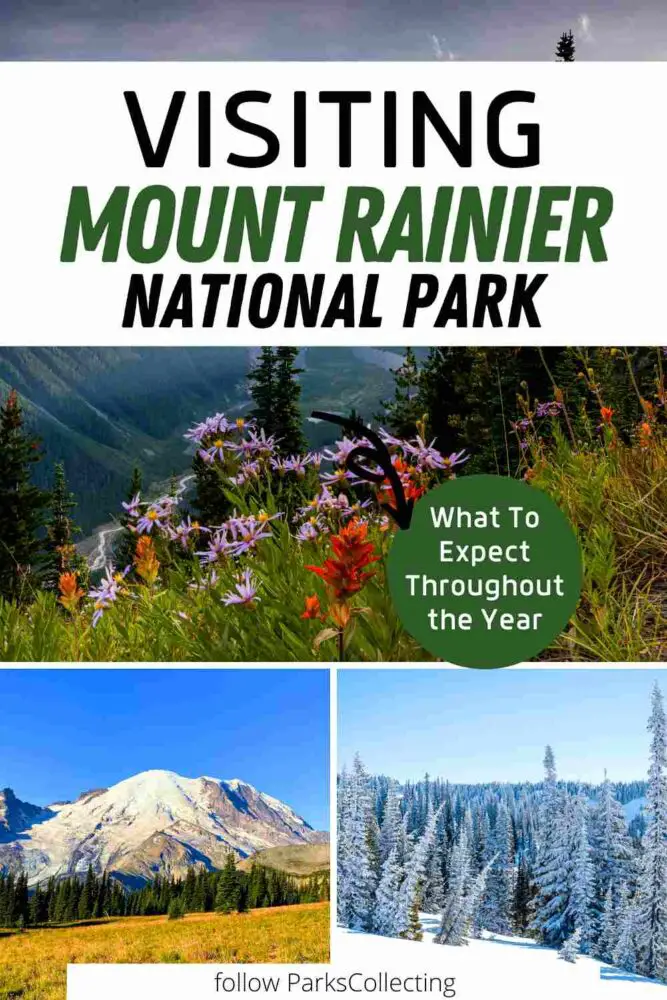
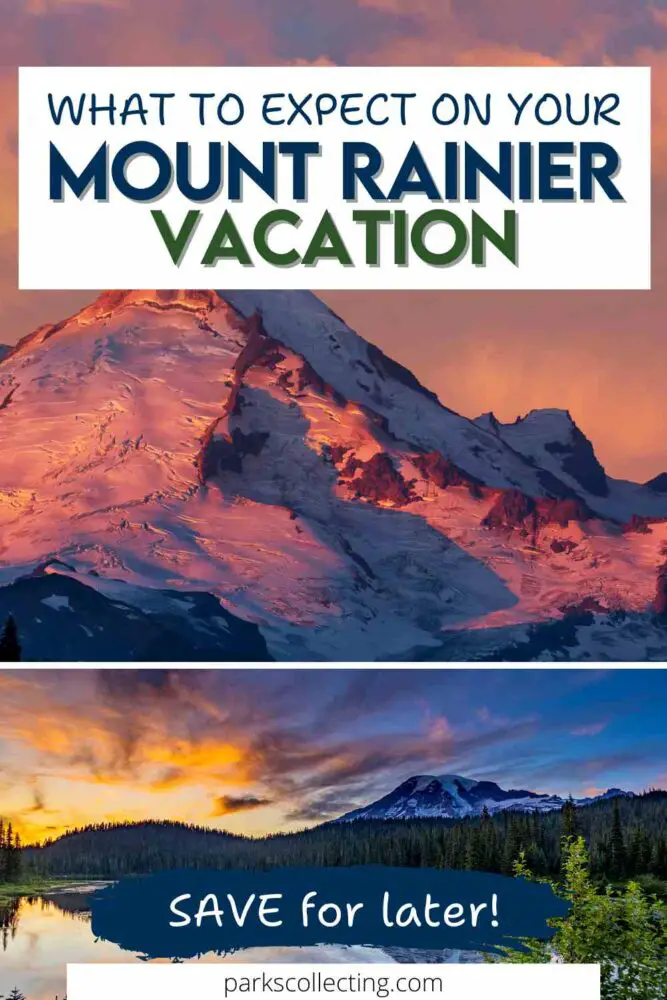
💡 Are you just starting to think about taking a national parks trip? Get Inspiration
‼️ Are you looking for helpful tips for visiting US national parks? Read articles that share useful tips on a range of national-park related issues
💻 Are you starting to plan a trip to Mount Rainier National Park? Read my Guide to Mount Rainier National Park
📋 Do you want a ready-made super detailed plan for your trip to Mount Rainier? Get a detailed 1 – 3-day Mt Rainier National Park Itinerary
💲 Are you ready to book your trip? Use these Planning and Booking Resources
📖 Do you want to read a book about US national parks? Check out my Recommended Reading Lists
About the Author
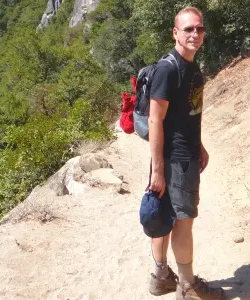
James Ian is a national park, camping and hiking expert.
He has dedicated his life to travel, visiting more than 80 countries, all 7 continents and most of the national parks in the United States. With over 35 years experience in the travel industry, James has worked on cruise ships, at resorts and hotels, and as a travel planner who’s helped hundreds of people plan successful trips to US national parks.
Based on his experience visiting our national parks multiple times, in-depth research and expertise as a travel planner, James has published detailed itineraries for many of the major national parks in the US. These itineraries, as well as in-depth park guides, and other resources will help you have your own incredible trip to US national parks without stress and hassle.
As a national park expert, James has contributed to many publications, including USA Today, Newsweek, Time Business News, Savoteur, Best Trip, and Wired.
I’m a member of the Amazon Services LLC Associates Program. As an Amazon Associate I earn from qualifying purchases.
